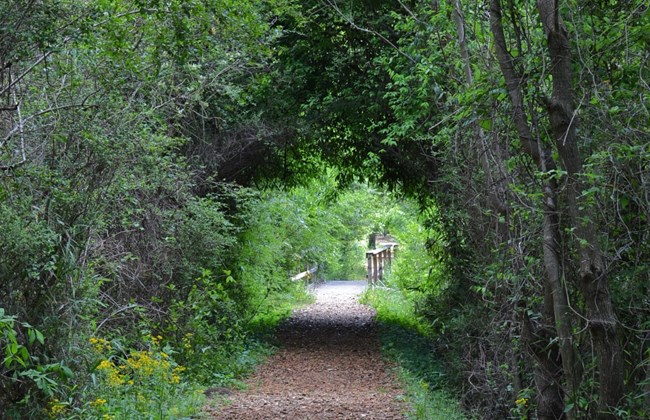
NPS Park TrailsOcmulgee Mounds National Historical Park has 8 miles of peaceful trails that give visitors opportunities to see 7 historical mounds as well as vibrant wetlands and forest environments. Most of the trails are a mile or less in length (one-way), but can be joined together to form longer loops if desired. Park benches are placed at various places along the trails for visitor convenience. Trail RulesAll visitors must be out of the park by 5:00PM. For your protection, please stay off the mound slopes. Pets are welcome but must be on a leash at all times. Fishing is permitted on the banks of the Ocmulgee River. A valid state fishing license is required. Fishing is NOT permitted in the Clay pond or from boardwalks and bridges. Bikes and ebikes are ONLY allowed on the River Trail, Heritage Trail, and road. Picnic in the picnic area only; no fires are permitted. If you need additional information, please call the Trails and DistancesVisitor Center to the Great Temple Mound (Main Path)- 1/2 mile This trail leads to three of Ocmulgee's most popular points of interest – the Earth Lodge, the Trading Post site, and the Great and Lesser Temple Mounds. This trail leads to one of a few surviving Civil War earthworks in McDougal Trail- 1/2 mile This trail is named after Captain Robert McDougal, who was in command of Heritage Trail- 1 3/4 miles This paved trail winds through the park and connects with the greater Ocmulgee River Greenway trail. This is the only trail that bikes can travel on in the park. Opelofa Trail- 1 mile "Opelofa" is a Creek word which means "like-a-swamp."There is abundant wildlife in the wetlands this trail runs through. It is great for bird watching;you may see egrets, osprey, herrings, and anhinga. The Walnut Creek wetlands has fish, turtles, frogs, and snakes. Part of the trail borders Walnut Creek which is occasionally home to beaver. Opelofa Loop Trail- 1/4 mile William Bartram (1739-1823) was a well-known naturalist who traveled through this area in 1774 and 1776. Bartram wrote about the "Old Ocmulgee Fields" in his journal. This trail winds lazily through the woods on both sides of the railroad bridge, which was built in 1874 and is on the National Historic Register. Walking this trail, you may encounter deer, squirrels, chipmunks, lizards and many varieties of birds. The Southeast Mound Trail– 1/4 mile This trail travels from the southeast corner of the Trading Post site to the Southeast Mound, and then south through the woods a short way to end at the park road. Little is known about this mound. Archaeologists believe it may have been damaged by plowing and erosion. The Hitchiti Village Site Trail– 1/4 mile This trail starts at the Trading Post Site and winds through a small area of woodland. Early Creek Indians (late 1600's) are believed to have occupied this area prior to the Yamassee War of 1715. Wildlife you may encounter on this trail are deer, turtles, squirrels, snakes, lizards and a variety of bird species. River Trail– 1/2 mile This trail winds through a wooded area to the Funeral Mound Loop– 1/4 mile This loop trail starts near the Funeral Mound parking lot at the end of the park road. It explores a more secluded part of the park as it descends from open fields alongside the park road into a stand of trees. Corn Field Mound Trail– 1/4 mile This trail is a grass trail that goes past the Corn Field Mound and prehistoric trenches, and ends at the Heritage Trail. The Corn Field Mound is believed to have originally been a ceremonial cornfield. Later the mound was built over the field. The purpose of the prehistoric trenches is unknown; it could have been used for a fortification or for borrow pits for mound building. |
Last updated: April 11, 2025
